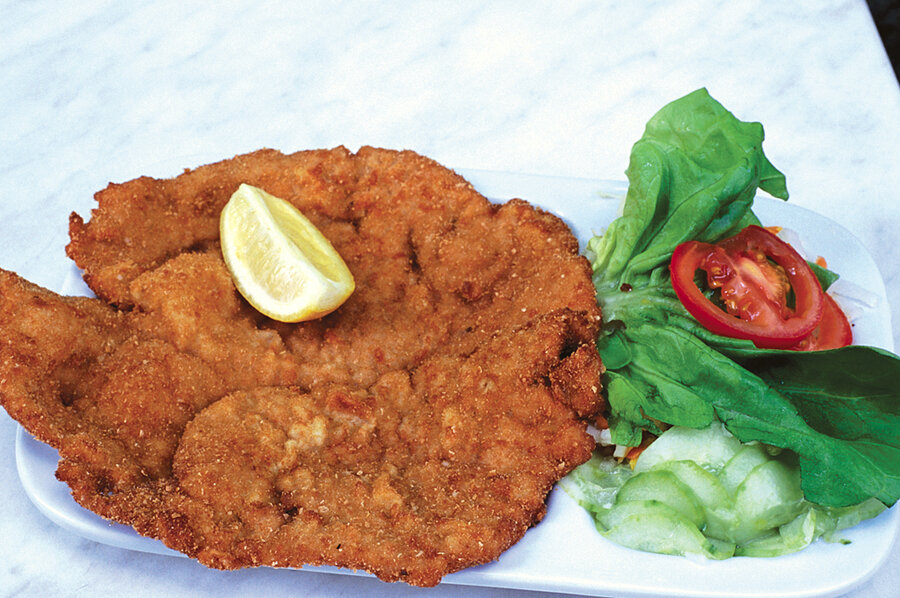A traditional German dish gets a curry make-over
Loading...
The first thing I noticed when I entered Lydia's living room was a beautifully framed photograph of her and her husband on their wedding day. Of course, I had to ask: What happens at a Hindu wedding ceremony when a German marries an Indian?
"The hardest part at the wedding," her husband, Chandu, told me, "was hiding the swastika. In India it's a popular religious symbol, but I did not want my German in-laws to misunderstand why it was there."
Lydia added that she loved dressing in Indian clothes and jewelry, but found it funny that his family thought she looked so Indian. "How is that possible?" she said, "I am so very blond."
We were standing in her spacious, spectacularly clean kitchen. We started prepping for dinner. Lydia planned to make me her favorite childhood dish, Wiener schnitzel.
She began when her husband returned from work. Tall, lean, he bent down to kiss her. And she smiled. They had met in the early 1990s on her birthday. She was working at the front desk of a Brussels hotel when he checked in. Within eight days of asking her out, he had proposed. She thought he was crazy.
"In a city full of glorious coffee bars and cafes," she reminisced, "he took me to Pizza Hut, of all places, to ask me this question!"
"And when she said no," he added, "I took the Pizza Hut menu and wrote down every phone number in the world where she could reach me, in case she changed her mind."
"Now, we begin," said my German friend, bringing me back to her kitchen. "When I was growing up, we ate Wiener schnitzel whenever we went out. It was our burger and fries. It is served in all family-style restaurants in Germany, comfort food that we loved. It is always served with fries and ketchup."
Whenever her mother made it at home, she told me, they would always serve it with a fresh green salad – and lots of cabbage. "We are German; we add cabbage to everything," she laughed and added a handful of grated cabbage to a large bowl of greens. This, I understood, would be our salad for the evening – greens, cabbage, peppers to be drizzled with Lydia's homemade dressing of olive oil, balsamic vinegar, coriander, salt, and pepper.
But I was itching for the pièce de résistance for the evening – the schnitzel.
She pulled out a box of pork chops from the fridge. "We will use these. But see, my mother would not like that because they don't have any fat on them. To make the Wiener schnitzel the German way, you need pork with fat! Not lean like I have." She went on to explain that while the traditional dish requires seasoning the meat with salt and then dipping it in egg and bread crumbs and deep-frying, she didn't use eggs or deep-fry.
Instead, she pulled out her secret ingredient – a jar of curry powder.
"Curry powder? In schnitzel?" I asked, surprised.
"My kids have acquired such a spicy palate thanks to their father that when I served schnitzel plain, they weren't too impressed. So I curried it up! And they loved it!"
I asked what the boys would think if they went back to Germany and tasted the schnitzel there. "They would love the deep-fried version, but I am sure the younger one would remark that the real way to make it is with curry," she said, her sweet laughter filling the air.
She placed the pork on a board and added salt and pepper and a few shakes of curry powder.
Next she took each piece and dredged it with bread crumbs, pressing the meat into the crumbs so it was well covered. A skillet was already on the stove with oil that was beginning to shimmer. In went the pork, and the aroma of curry filled the air. I could hear her husband in the other room: "Smells divine. Is it done yet?" She checked by pressing down with her finger on the pork. "It is done when it is no longer soft."
And with that, dinner was served. "I made it this way for my mom many years ago," she told me.
Her mom had returned to Germany with a suitcase full of curry powder.





